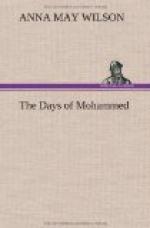Upon the evening of the following day, Amzi and Yusuf set out in quest of Mohammed, to whom the manuscript had not yet been given. Stopping at the house of Cadijah, a stone building having some pretensions to grandeur, they learned that Mohammed had left the city. Accordingly, thinking he would probably be found in the Cave of Hira, they took a by-path towards the mountains.
The sun was hot, but a pleasant breeze blew from the plains towards the Nejd, and, from the elevation which they now ascended, Yusuf noted with interest a scene every point of which was entirely different from that of his Persian home—different perhaps from that of any other spot on the face of the earth; a scene desolate, wild, and barren, yet destined to be the cradle of a mighty movement that was ere long to agitate the entire peninsula of Arabia, and eventually to exercise its baneful influence over a great part of the Eastern Hemisphere.[7]
Below him lay the long, narrow, sandy valley. No friendly group of palms arose to break its dreary monotony; no green thing, save a few parched aloes, was there to form a pleasant resting-place for the eye. The passes below, those ever-populous roads leading to the Nejd, Syria, Jeddah, and Arabia-Felix, were crowded with people; yet, even their presence did not suffice to remove the air of deadness from the scene. Of one thing only could the beholder be really conscious—desolation, desolation; a desolate city surrounded by huge, bare, skeleton-like mountains, grim old Abu Kubays with the city stretching half way up its gloomy side, on the east; the Red mountain on the west; Jebel Kara toward Tayf, and Jebel Thaur with Jebel Jiyad the Greater, on the south.
[Illustration: “Read, O Mohammed, and see him who was able to restore the withered hand.”—See page 23.]
Yusuf watched the people, many of whom were pilgrims, swarming like so many ants below him towards the Caaba, which was in full view, standing like a huge sarcophagus in the center of the great courtyard. In the transparent air of the Orient, even the pillars supporting the covered portico about the courtyard were quite visible. Yusuf had observed the great system of barter, the buying and selling that went on beneath the roof of that long portico, within the very precincts of the temple set apart for the worship of the Deity, and, as he watched the pigmy creatures, now swarming towards the trading stalls, now hastening to perform Tawaf about the temple, he almost wept that such sacrilege should exist, and a great throb of pity for these erring people whose spiritual nature was barren as the vast, treeless, verdureless waste about them, filled his breast.
Amzi directed his attention towards the east, where the blue mountains of Tayf stood like outposts in the distance.




